








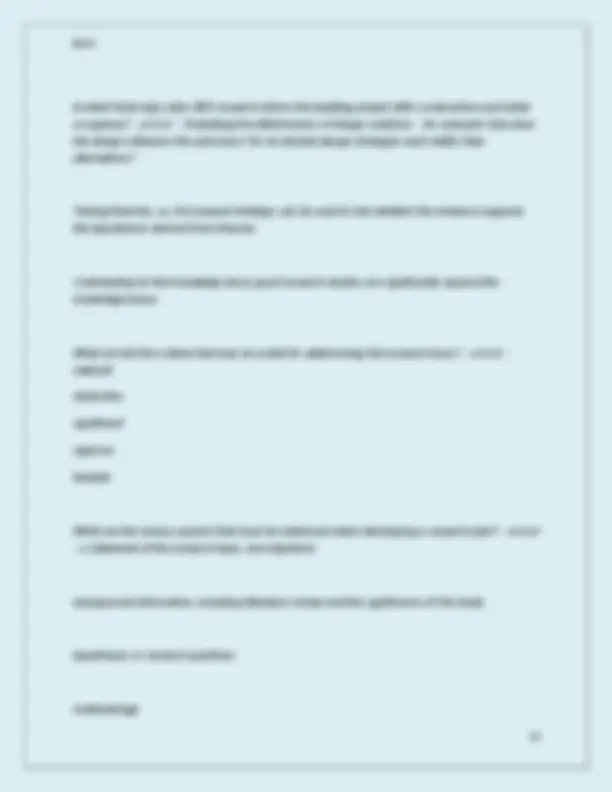
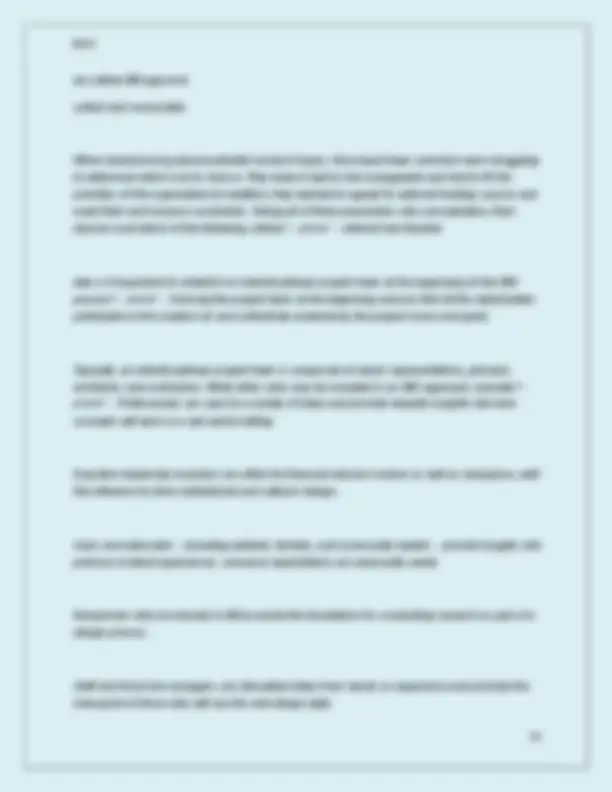




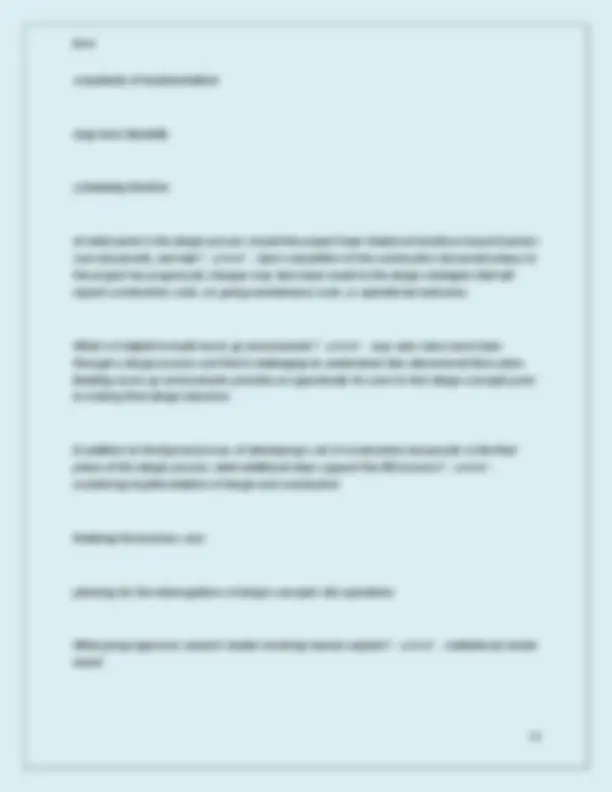




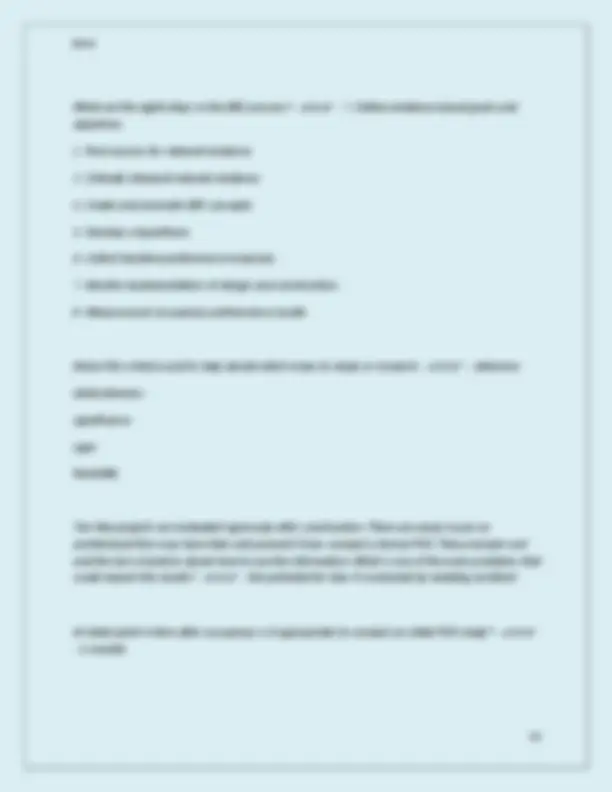
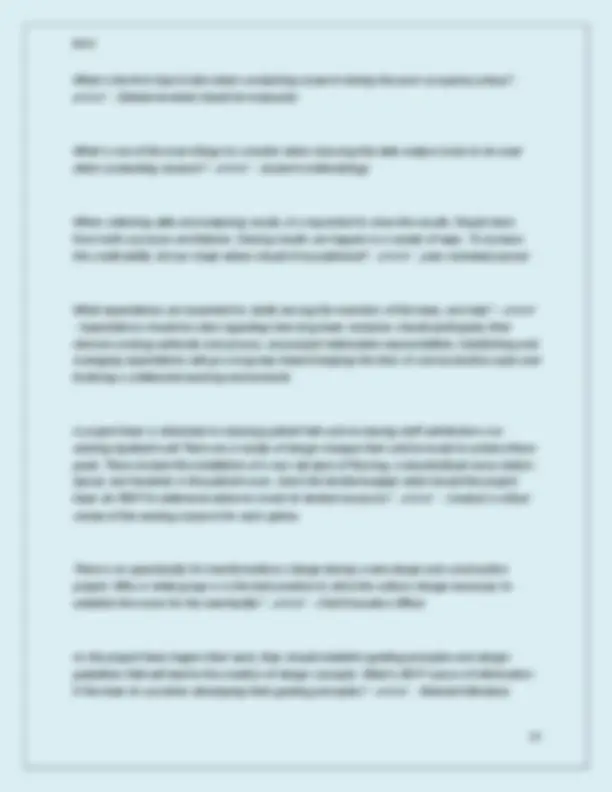
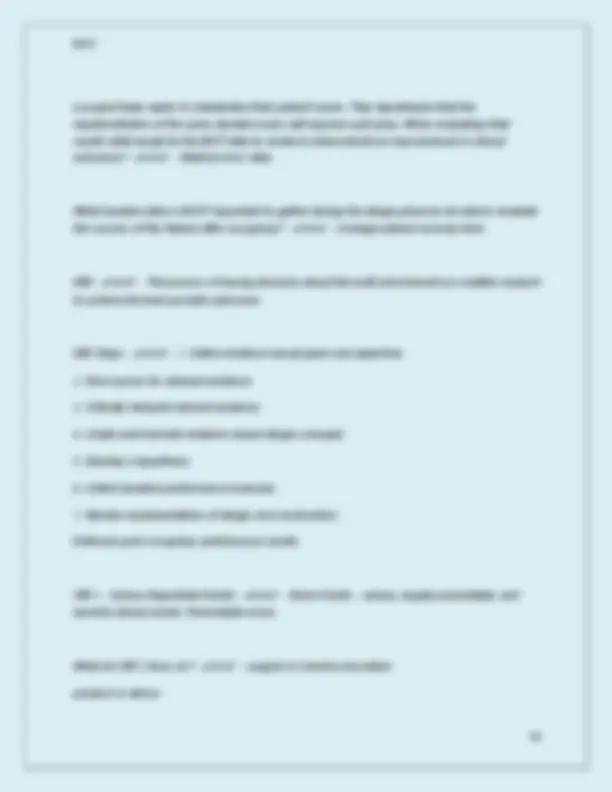

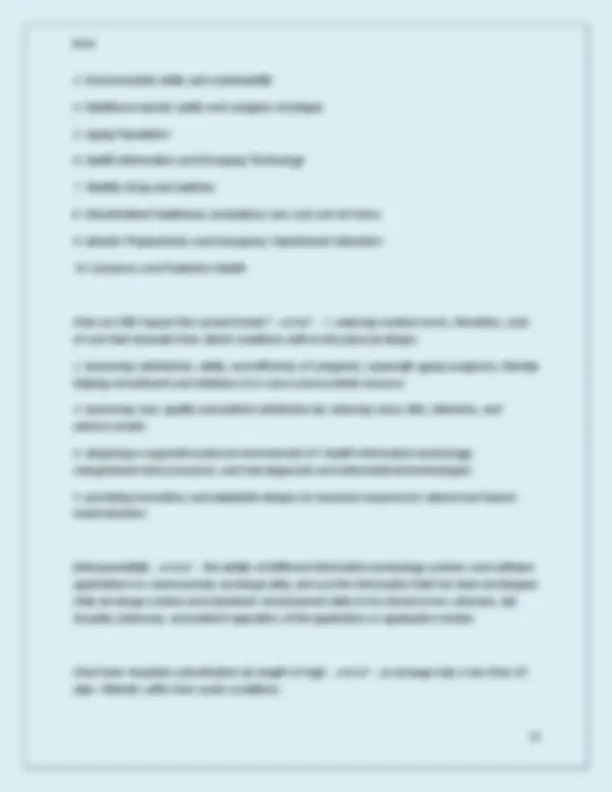
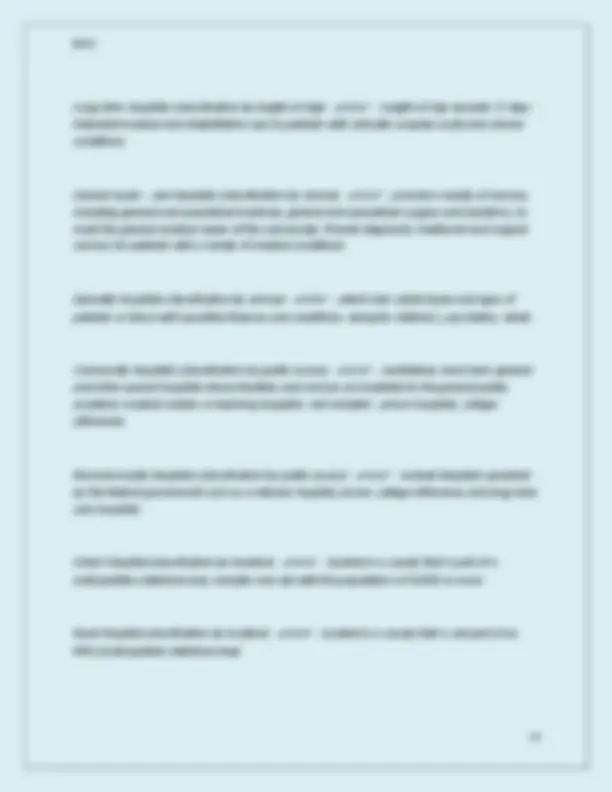

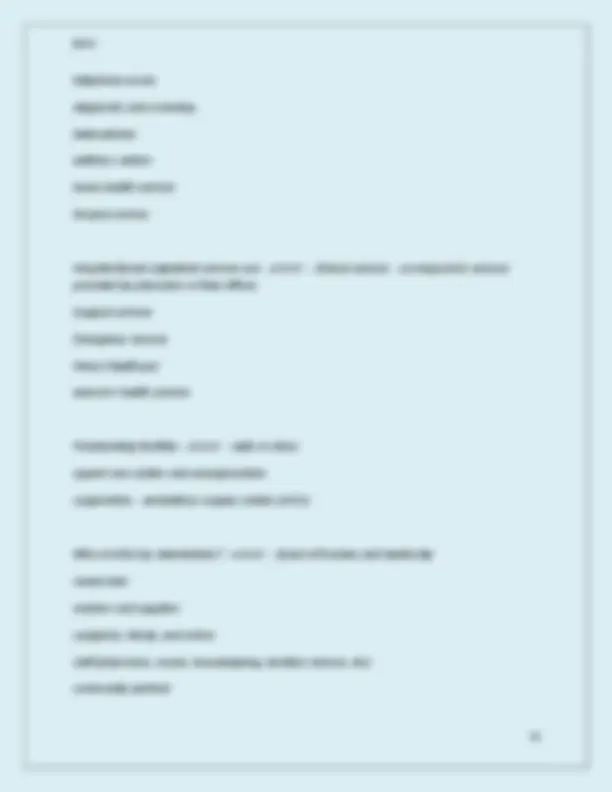





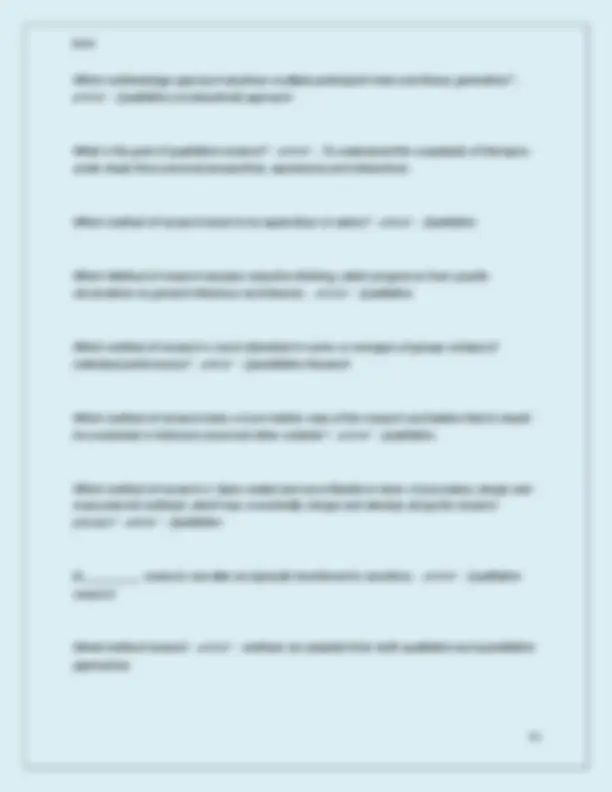


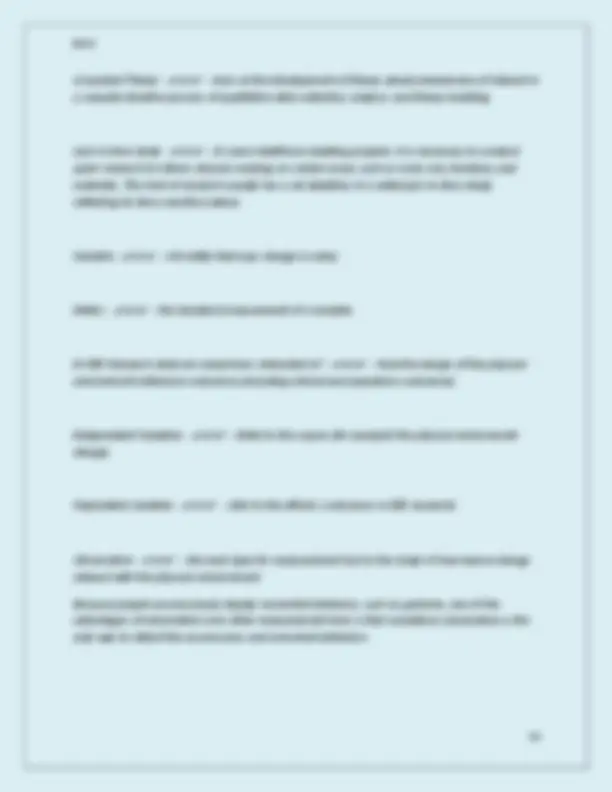
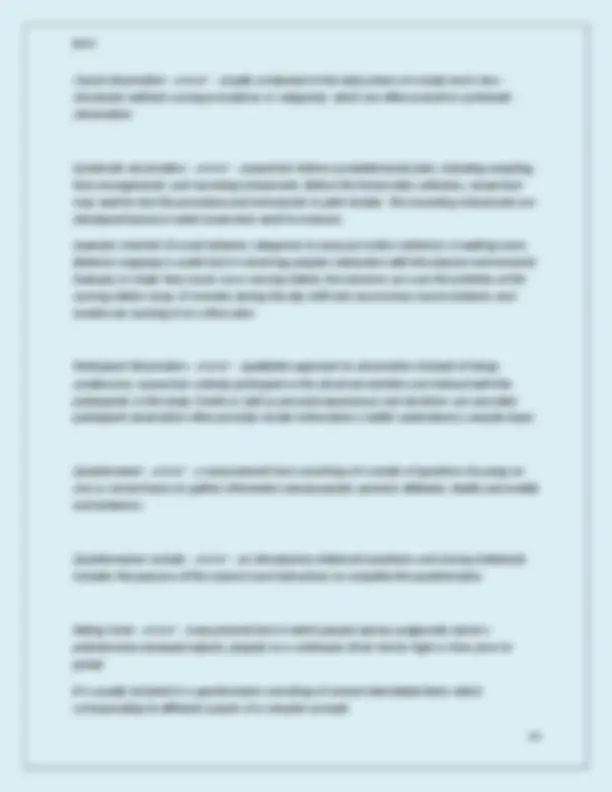
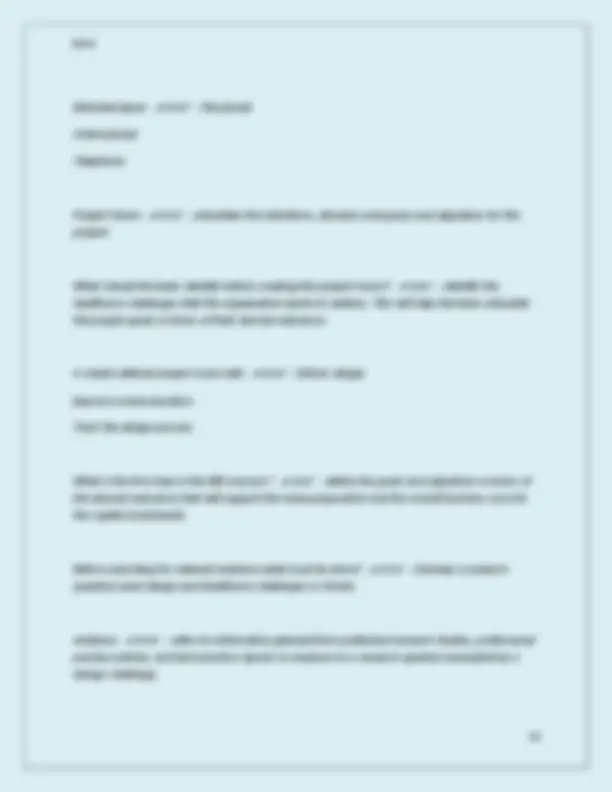





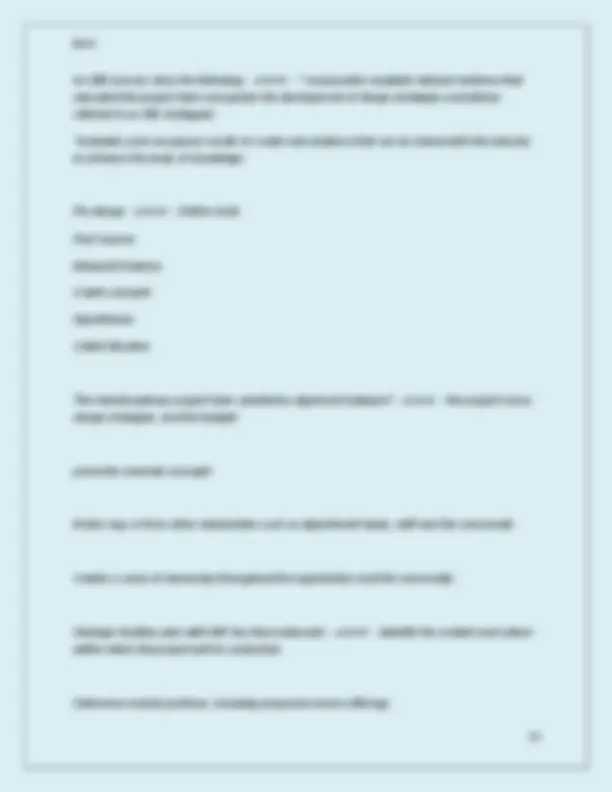



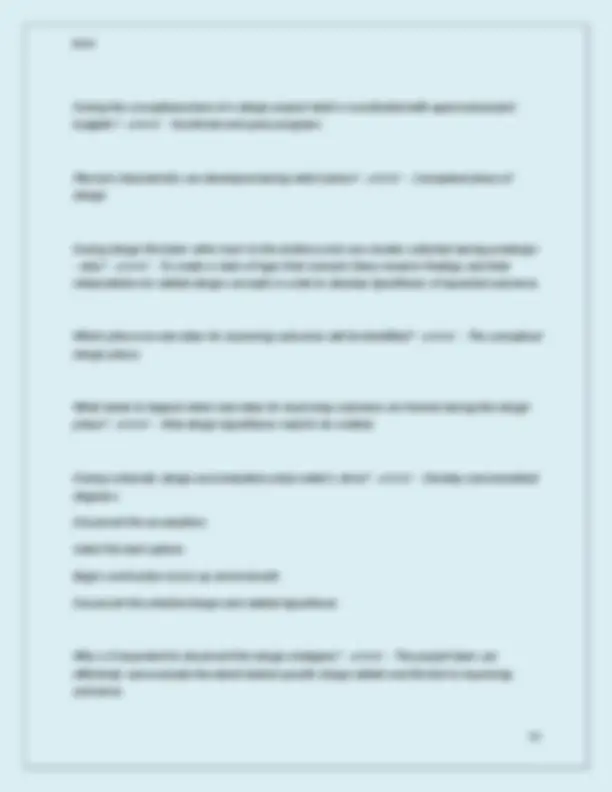










Study with the several resources on Docsity

Earn points by helping other students or get them with a premium plan


Prepare for your exams
Study with the several resources on Docsity

Earn points to download
Earn points by helping other students or get them with a premium plan
Community
Ask the community for help and clear up your study doubts
Discover the best universities in your country according to Docsity users
Free resources
Download our free guides on studying techniques, anxiety management strategies, and thesis advice from Docsity tutors
A comprehensive set of questions and answers related to the edac (evidence-based design accreditation and certification) exam. It covers key concepts in evidence-based design, including the ebd process, stakeholder perspectives, the environment of care (eoc), and the impact of design on patient and staff outcomes. Valuable for students and professionals seeking to understand and apply evidence-based design principles in healthcare settings.
Typology: Exams
1 / 64

This page cannot be seen from the preview
Don't miss anything!

























































Why is it important to establish an interdisciplinary project team at the beginning of the EBD Process. - ✔✔✔ - Forming the project team at the beginning ensures that all the stakeholders participate in the creation of, and collectively understand, the project visions and goals. What expectations are important to clarify among the members of the team, and why? - ✔✔✔
How can EBD positively influence the challenges represented by the current trends? - ✔✔✔ - EBD can positively influence these challenges by designing healing and therapeutic environments that help reduce errors, improve patient ad staff satisfaction, enhance efficiency and support the latest technological advances such as HIT and genomics. What is the definition of evidence-based design? - ✔✔✔ - The process of basing decisions about the built environment on credible research to achieve the best possible outcomes. What are the eight steps of the EBD process? - ✔✔✔ - 1. Define evidence-based goals and objectives
urgent-care centers and emergicenters surgicenters mobile, medical, diagnostic, and screening services emergency medial technicians List the nine key stakeholders in healthcare facilities. - ✔✔✔ - board of trustees and leadership researchers and designers vendor/suppliers patients caregivers/family/visitors staff community partners community organizations donors Why is it important to consider the perspective(s) of hospital staff when designing a healthcare facility? - ✔✔✔ - Staff can provide insight into the design of effective and efficient facilities based on their day-to day experience of what does and does not work. Fro example, housekeeping staff are intimately aware of what colors and textures show dirt easily and wear prematurely, while clinical staff can provide input about the effective layout of supply and equipment spaces, work-surface heights and locations, as well as actual care provision areas; information technology staff can help forecast space requirements for future equipment needs. Why is it important to consider the perspective(s) of community-based organizations or associations in the design of healthcare facility? - ✔✔✔ - Many associations are in a position to provide expert advice for the care of their constituencies. For example, the national Association of the Deaf is available to consult on design interventions that help to accommodate the needs
of the hearing impaired. Public institutions such as libraries, historical societies, and disaster committees can also provide important insights that benefit facility design. Which professionals might comprise a hospital design research team? - ✔✔✔ - A research team may included individuals with research degrees, students, or those with experience in research related TO THE BUILT ENVIRONMENT. OTHER KEY MEMBERS OF A RESEARCH TEAM MAY INCLUDE THE HOSPITAL'S quality improvement, rewords, finance, and information systems managers, as well as clinicians who will aid in identifying, taking, and monitoring clinical and financial indicators significant to the project goals. What are the six components that make up the Environment of Care (EOC)? - ✔✔✔ - Delivery of care model (concepts) facility and service users (people) systems design layout and operations planning physical environment design process and implementation What type of facilities give patients a wide range of healthcare choices ad attempt to meet consumer needs of convenience and cost reduction? - ✔✔✔ - freestanding facilities When an individual receives personal care on an ongoing basis because of a disability or chronic illness that limits his or her ability to function , what is the name of this type of care? - ✔✔✔ - long-term care Hospitals have expanded their outpatient departments, which can be broadly classified into fie main types. What is one category that can be classified as hospital-based outpatient service? - ✔✔✔ - women's health
How is research defined in the context of EBD? - ✔✔✔ - in EBD, research general refers to empirical research, the systematic investigation of the tangible facts (for example, empirical data) aimed at gaining knowledge, making discoveries, testing or revising theories, and applying the new knowledge. Empirical data refers to the information that can be directly sensed (seen, heard, touched tasted, and smelled) and is demonstrable to other people. How can existing data within a healthcare facility be used in EBD, given institutional approval? - ✔✔✔ - Given institutional approval, this database of information may be mined to explore how changes to the built environment relate to health, performance, satisfaction, and economic outcomes. Strong evidence has confirmed that certain design characteristics impact patient and staff outcomes in four key areas. What are these key areas? - ✔✔✔ - reduction in staff stress and fatigue improvement in patient safety reduction in patient stress improvement in overall healthcare quality What are three sources for relevant data that could be found within the healthcare organization itself? - ✔✔✔ - 1. measurements of the Environment of Care (EOC), including the daily changes in temperature, light, sound, location, dimension, distance, materials, furnishings, or equipment used i the care setting
what differentiates the EBD process from the typical design process? - ✔✔✔ - uses research to develop and evaluate design innovations. At which phase of the project should stakeholders use research to understand which environmental elements are the best design options to improve outcomes? - ✔✔✔ - predesign/design How should research be used after construction is completed and the building has been occupied for several months? - ✔✔✔ - to evaluate the effectiveness of design strategies When specific information about the built environment can be recorded over time and properly measured, what type of relationship between features of the built environment and outcomes can be asserted? - ✔✔✔ - causal List the key steps in an EBD process: - ✔✔✔ - Define evidence-based goals and objectives. Find sources for relevant evidence. Critically interpret relevant evidence. Create and innovate EBD concepts. Develop a hypothesis. Collect baseline performance measures. monitor implementation of design and construction. measure post-occupancy performance results. What is the value of conducting visioning sessions with key patient, staff and community members when launching the project? - ✔✔✔ - They clarify the project message, image, brand, or theme as well as identify desired features or amenities and services to be included in the project.
Long term care Service types: - ✔✔✔ - Institutional long- term care Independent living Assisted living Skilled nursing care Continuing care retirement communities (CCRCs) memory care the various settings in which outpatient service delivery are found in the US healthcare delivery system can be grouped as follows: - ✔✔✔ - private practice long-term care hospital-base outpatient services public health services freestanding facilities public and voluntary clinics complementary and alternative medicine mobile meical telephone access diagnostic and screening telemedicine wellness centers home health services hospice service
Classification by size - ✔✔✔ - small: hospitals wit fewer than 100 beds medium: hospitals with 100 to under 500 beds large: hospitals with more than 500 beds What Differentiates evidence-based design (EBD) from typical design? - ✔✔✔ - its emphasis on using research to support design decision making and evaluated design innovations. What are the components of the research process? - ✔✔✔ - research question(s) literature review hypothesis research plan pilot study data collection data analysis report future research What are the three methodologies that can be used in EBD research? - ✔✔✔ - quantitative approach qualitative approach mix methods approach What are the major roles of researchers in evidence-based design? - ✔✔✔ - decide on details of research plan conduct pilot study
The goal of this research methodology is to explain and predict phenomena by examining the relationships between empirically measured variables. - ✔✔✔ - quantitative A positive correlation exists when one variable_________ and another variable tends to ___________.
What are four sources for existing evidence? - ✔✔✔ - online journals databases abstracting and indexing services in-house databases search engines websites federated search technologies Open Archives Institute How can information be organized in a repository? - ✔✔✔ - The simplest retrieval systems are based on most standard library catalog rules. With these rules, a variety of spreadsheets, databases, or hierarchical file structures can be used for retention and retrieval purposes. These variables are not under the control of the experimenter and are difficult to isolate to cause and effect because they vary systematically form the independent variable. - ✔✔✔ - confounding What is the most efficient way to keep track of evidence you have found in the research literature? - ✔✔✔ - Develop a searchable, electronic database based o standard library catalog rules, including standard cataloging access points. The key steps of the evidence-based design process should be implemented through the lens of the project vision, the business case, and _____________. - ✔✔✔ - project goals and objectives Healthcare designers want to collect experiential knowledge from major project stakeholders. One source for this knowledge can be acquired from industry leaders, facility staff, nurses, and physicians. This type of experiential knowledge is ___________. - ✔✔✔ - expert
research design variables and measurements data collection procedures including: settings, populations, samples, ad protection of human subjects data analysis procedures logistics, including the roles and responsibilities of individual team members, budget, and tie line references What type of variables should be considered in data collection? - ✔✔✔ - independent variables dependent variables confounding variables What needs to be considered when preparing for data collection? - ✔✔✔ - Types of data data collection steps
recording the data data anaysis How can results be reported? - ✔✔✔ - participating in conferences and symposia written research reports articles in peer-reviewed journals articles i trade magazines Researchers are interested in the relationship between the design of the physical environment and healthcare-related outcomes. Therefore both the environmental variables and the outcome variables will be measured. in what order are the above variables listed. - ✔✔✔ - independent, dependent Researchers hypothesized that different nature sounds (running water, bird song, waves) would have varying impacts on pain thresholds. They conducted their study and found a small difference in outcomes based on they type of sound; the statistical test on the results indicated a p value of .15. The researchers should: - ✔✔✔ - Accept the null hypothesis -- the results occur by chance. During the data collection phase, researchers do all of the following EXCEPT: - ✔✔✔ - "analyze the data"
Why should the interdisciplinary project team include community leaders? - ✔✔✔ - The team can gain insights about consumer expectations. What can staff and front-line managers contribute o the interdisciplinary project team? - ✔✔✔
What is articulated in the project vision? - ✔✔✔ - The vision articulates the intentions, directions goals, and objectives for the project. In addition, it is critical to have a clearly defined vision that specifies a commitment to using an EBD process. In the visioning process, what three questions are asked to help establish goals that link the project to the desired outcomes? - ✔✔✔ - What is the project trying to achieve? What is the problem? What design concepts should b considered to meet these goals and objectives? What are the two primary purposes of the functional narrative? - ✔✔✔ - The design team will use the functional narrative during the design process as a road-map that describes how space needs to be configured to promote efficient and effective operational flow. The administrative transition team will use the functional narrative to identify the process, people, and technology changes that need to be further developed during the deign phases and implemented prior to occupying the new facility. What are the six elements of functional and space programming included when using an EBD process? - ✔✔✔ - collecting existing data to establish internal baselines using additional data by finding external benchmarks addressing Environment of Care components